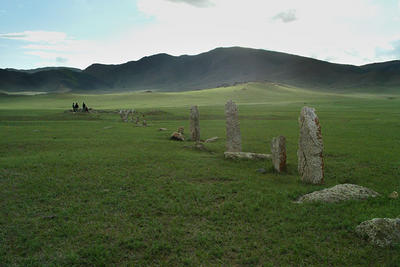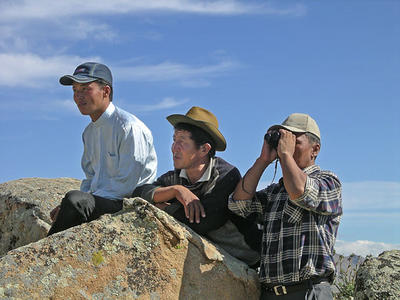 Only a half grown weta, but by insect standards a fairly large animal, its body roughly 5–6 cm long and about as thick as my little finger. It flipped itself upright and raised its spikey hind legs in the air, jaws open: the classic weta defensive posture. I haven't seen a live weta for quite a while, and have been keen to photograph one, so I scooped it up into a jar, added a piece crumpled paper towel for it to cling to and a disc of carrot for it to eat. I no longer have any urge to keep “bugs in jars”—I much prefer just looking at them going about their lives, or I'll try for a photo if I'm in that mood—but that evening I was leaving to meet friends and if I wanted a weta photo then this weta would have to put up with a brief stay in a jam jar with a free lunch.
Only a half grown weta, but by insect standards a fairly large animal, its body roughly 5–6 cm long and about as thick as my little finger. It flipped itself upright and raised its spikey hind legs in the air, jaws open: the classic weta defensive posture. I haven't seen a live weta for quite a while, and have been keen to photograph one, so I scooped it up into a jar, added a piece crumpled paper towel for it to cling to and a disc of carrot for it to eat. I no longer have any urge to keep “bugs in jars”—I much prefer just looking at them going about their lives, or I'll try for a photo if I'm in that mood—but that evening I was leaving to meet friends and if I wanted a weta photo then this weta would have to put up with a brief stay in a jam jar with a free lunch. That free lunch, I'm ashamed to say, turned into a free dinner, breakfast, and lunch. Then another dinner, breakfast and lunch. And another... I think the weta was in the jar for about 3 days. I checked it often;  made sure it still had plenty of carrot (the disc had actually begun to sprout, so it was good tucker) and left the lid off from time to time. The weta began eating carrot the first night, and began crapping carrot the second night. I'd like to say it seemed pretty happy in its new jam-jar-and-paper-towel home with ad lib. food, but it's hard to tell whether or not a weta's happy when it's doing nothing but lying there with its palps on its food to make sure the carrot doesn't escape. Besides, exoskeletons make it hard to express emotions visibly—all you can really do is gesticulate with the articulated bits of your body. This weta wasn't waving anything, so I assumed it was perfectly contented.
made sure it still had plenty of carrot (the disc had actually begun to sprout, so it was good tucker) and left the lid off from time to time. The weta began eating carrot the first night, and began crapping carrot the second night. I'd like to say it seemed pretty happy in its new jam-jar-and-paper-towel home with ad lib. food, but it's hard to tell whether or not a weta's happy when it's doing nothing but lying there with its palps on its food to make sure the carrot doesn't escape. Besides, exoskeletons make it hard to express emotions visibly—all you can really do is gesticulate with the articulated bits of your body. This weta wasn't waving anything, so I assumed it was perfectly contented.
That, of course, was a totally unwarranted assumption. I made it because I was feeling guilty. I'd rationalised the capture by arguing that I'd photograph my little friend the next day, then let it go. Several days later, I'd still not photographed it, and was still so consumed by all the other things I had to do that the prospect of setting up the camera and finding a natural-looking background on which to photograph the weta seemed remote.
On Thursday evening I delivered the slide show & talk to the PNTMC. I showed images of last year's overseas trip, particularly the time in Mongolia, but also Japan, China, Italy, and Switzerland, and finished with a selection of photos of climbing in Arthur's Pass and birds, insects, and spiders. Despite good feedback, I felt disappointed with the quality of the projected images—digital projection still has a long way to go to match projected film (slides)—and the deflated feeling stayed with me right through the next day. When I got home after the talk, my weta was still waiting, unphotographed, in its jar with its carrot.
Last night, worn out and affected by a feeling of low intensity incompetence, I removed the lid from the jam jar and carefully extracted the paper towel with the weta clinging to it. On being removed from the jar,  the weta scuttled up the dangling paper and onto my hand. I put the jar down, dropped the paper towel and the weta ran up my arm. I cut it off with my left hand, so it ran up my left arm. After swapping arms several times, I remembered what I should've done from the outset, and held my hand upright, whereon the weta ran up to my hand and perched there. I moved over to the door, opened it and stepped out onto the verandah, said goodbye and good luck, and flicked the weta gently into the night, from where it had arrived several days ago.
the weta scuttled up the dangling paper and onto my hand. I put the jar down, dropped the paper towel and the weta ran up my arm. I cut it off with my left hand, so it ran up my left arm. After swapping arms several times, I remembered what I should've done from the outset, and held my hand upright, whereon the weta ran up to my hand and perched there. I moved over to the door, opened it and stepped out onto the verandah, said goodbye and good luck, and flicked the weta gently into the night, from where it had arrived several days ago.
When I stepped inside, my mood had lifted—substantially; the feeling was almost tangible; a kind of relief. Something about the weta's confinement had clearly oppressed me. The paradox (or is it irony?) is that if the weta had any awareness of what had happened, it would probably have been utterly pissed off with me, not for its confinement, but for being tossed out of its safe, lazy environment, where it need do nothing but eat and sleep. Now it's out in the wide world, where the risks of being eaten by something—rat, mouse, cat, ruru2, inattentive sheep—are high. It has to search for its food; it has to find somewhere to shelter during the day so it won't be eaten or shrivel up in the sunlight. It faces all the problems of moment-by-moment survival; problems it didn't face in its jam jar.
In other words, it's free.
1 Red bands are NZ-iconic, short gumboots.
2 Ninox novaeseelandiae; the morepork; NZ's only extant native owl.
[The photos are all from Mongolia; taken with the little, long-obsolete, point-and-shoot Pentax Optio 555. We never discovered the significance of the line of standing stones, but the place had a strange feel to it—an aura that compelled respect and reflection. That's Yatga and John with the horses; the final photo is of three local men checking out my binoculars on the hill overlooking the Ider Gol where we camped and started our fortnight on horseback. Check out John's Zavkhan Trekking website if you want to find out more.]
Photos and words copyright 2005 Pete McGregor
No comments:
Post a Comment